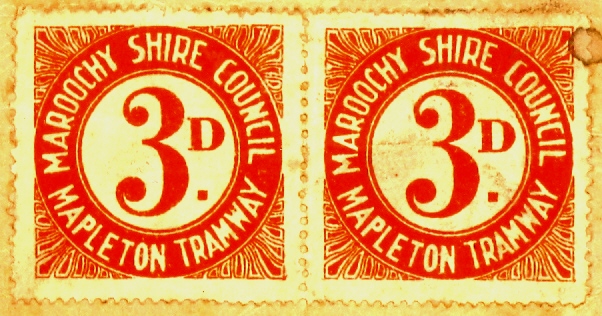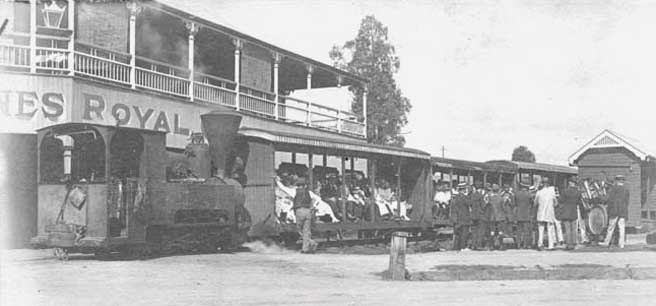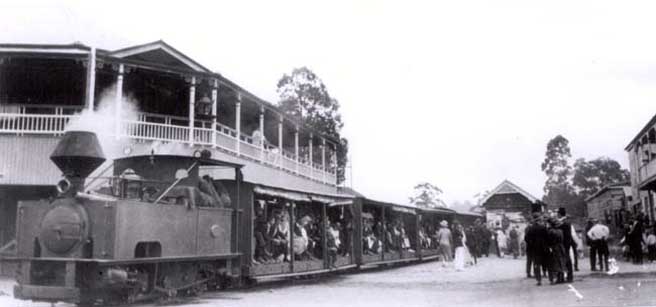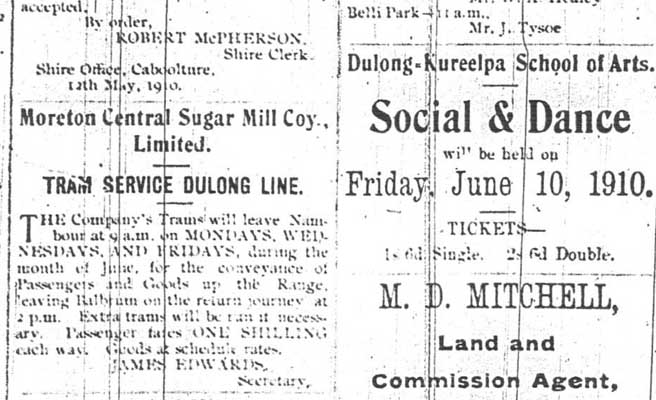
The sugar trams become general carriers
Because of the poor roads
existing at the time, many people living in localities served by tramlines began
to request a regular transport service to and from Nambour for goods and passengers, and
they pressed for the tramway network to be made available to them as a general
carrier. The Chronicle newspaper took
up the cudgels on their behalf.
People connected with the Mill management would have noticed the Queensland Railways trains going past, and they would have concurred with the idea that perhaps the trams could earn money by carrying freight and passengers like their full-sized counterparts on the QR. This would be especially feasible in the 'slack season'. This was the six months between January and June each year when the Mill was not crushing cane, and the tramway would otherwise be to a large extent out of use and the two locomotives and rolling stock idle. By 1909 public demand and Mill financial requirements converged, and during the Christmas holidays of December 1909 to January 1910, the Mill's Board decided to trial a two-month public transportation service along the tramway from Nambour down the Petrie Creek line as far as Cedar Tree, a distance of two miles. In this way, the Mill management hoped to gauge the viability of using the trams as general carriers.
To manage the service, a bogie passenger carriage with a capacity of 32 people was built and put into use. Goods to be carried were loaded into a van or onto a wagon in the Mill yard. Then the tram moved downhill into Mill Street and stopped between the Club and Royal George Hotels, where passengers were able to board. These trams ran regularly twice a day, the fares being a shilling for adults, and sixpence for children. The services did not interfere with the transport of cane, for the crush had finished. This trial was so successful that the Mill's Board of Directors felt confident enough to expend 500 pounds on an accident insurance policy for passengers. They decided to continue the service, albeit with a modified timetable, and from then on the trams acted as general carriers, transporting goods, produce and passengers all through the year, but especially during the slack season. More passenger and goods vehicles were built, and loop lines and waiting sheds constructed to improve the service.
Passengers were issued with tickets that carried the following notice:
|
Moreton Central Sugar Mill Company Limited SPECIAL NOTICE TO PASSENGERS This Company is not a common carrier. It only carries Passengers as it thinks fit, and solely by way of obligement. Passengers are carried solely at their own risk. The Company will not be liable for any accident or damage, or loss of any kind, or on account even for the negligence of of its own servants or agents, or even if Passengers are landed at their wrong destination. The Company
|
Adhesive freight stamps were placed on goods carried according to their weight, e.g. 3d for parcels up to 28 pounds or cases of fruit, and bulk goods at 7/6 per ton. Firewood for delivery to outlying homes continued to be carried, and passengers were charged fares according to the distance travelled.

Freight stamps used on the Dulong branch.
The company extended the line for another three-quarters of a mile to Deepwater (Bli Bli) in 1912, where there was a wharf for river craft. Passengers could transfer to boats there, which would take them down the river to Maroochydore. A line to Coolum was opened by the then Governor of Queensland, Sir Matthew Nathan on 2nd November 1923. It extended the existing cane line from Nambour by four miles from Dunethin Rock to Coolum. Built to haul cane and some goods traffic, it also carried passengers on weekend excursions from Nambour. The passenger service was regular from 1925 to 1935, when diminishing numbers made the service uneconomic.

Moreton prepares to take a train down Howard Street from the Royal George Hotel on the corner of Currie Street and Mill Street. As the locomotive has not yet been fitted with a tender, the picture must have been taken earlier than 1923, and possibly in 1920. This must have been a special occasion, as the Nambour Town Band is in attendance and playing. Photograph courtesy Sunshine Coast Libraries

Maroochy is at the same location in 1925. The Club Hotel is visible at right. Photograph courtesy Sunshine Coast Libraries.
A notice that the trams
were available for timetabled public use on the Nambour to Dulong branch appeared in The
Chronicle of 14th May 1910. The local settlers were pleased with this new
transport facility, saying that "in wet weather the iron horse is available
all the time". Their positive response encouraged the Mill to place the
following announcement in The Chronicle
on 4th June:

Image courtesy Sunshine Coast Libraries
Moreton
Central Sugar Mill Coy., Limited.
The Company's Trams will leave Nambour at 9 a.m. on MONDAYS,
WEDNESDAYS AND FRIDAYS, during the month of June, for the conveyance of
Passengers and Goods up the Range, leaving Balbrum on the return journey
at 2 p.m. Extra trams will be run if necessary. Passenger fares
ONE SHILLING each way. Goods at schedule rates. JAMES
EDWARDS,
The advertisement above makes reference to a place called 'Balbrum', a name not used today. A map published in the Queensland Agricultural Journal of
1st January 1903, page 48 (reproduced below), shows the Nambour - Dulong Tramline as it then existed, terminating at F. M. Murtagh's farm below the
Highworth escarpment. A dotted continuation shows the proposed extension to John Murtagh's property at Dulong. On the map, a low ridge runs from today's
Dulong Lookout north-west to today's Kureelpa Hall. It then continues about half a mile beyond the Hall, gaining height. This section is marked as the 'Bolbrum
Spur', and the area west of it, 'Bolbrum'. Comparison with modern maps shows that this district is now known as West Kureelpa, and the Shamley Heath estate
is located there. As the Dulong tramline terminated at the site of the Kureelpa Hall in 1910, it seems likely that 'Bolbrum' or 'Balbrum' refers to the area
around the Kureelpa Hall and to the west, as far as the South Maroochy River.
TRAM SERVICE
DULONG LINE
Secretary.
Click here to show a page from the Nambour Chronicle of March 27, 1931, advertising tram timetables to Maroochydore and Coolum Beach for the forthcoming Easter holidays. It also advertises the official opening of the new Maroochy Shire Council Chambers, an elegant building with a white colonnade, which replaced the wooden Nambour Town Hall, destroyed by fire on October 23, 1929 (see lower right corner).
The passenger services to Deepwater operated until 1927, and to Coolum until 1935, after which time they
were replaced by bus transport.